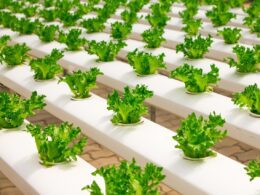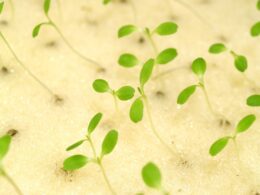Do you want to grow your own vegetables but don’t have a lot of space? Hydroponics might be the solution for you! But what about adding fish to your hydroponic system? Is it possible? The answer is yes!
Hydroponics is a method of growing plants without soil, using only water and nutrients. Adding fish to the system is called aquaponics, which is a symbiotic relationship between fish and plants. The fish produce waste that is converted by bacteria into nutrients for the plants, while the plants clean the water for the fish.
This means that you can have fresh vegetables and fish in the same system, without the need for soil or chemical fertilizers. But before you start, there are some things you need to know about choosing the right fish, setting up your system, and maintaining it for optimal growth.
What is Aquaponics?
Aquaponics combines aquaculture and hydroponics to create a sustainable system where plants and fish work together to create a self-sufficient ecosystem. This means that the plants and fish are interdependent on each other for survival. The fish produce waste that is broken down by bacteria and turned into nutrients for the plants. In turn, the plants absorb these nutrients, cleaning the water for the fish.
One of the benefits of aquaponics is that it’s an incredibly efficient way to grow food. Compared to traditional gardening, aquaponics uses up to 90% less water. This is because the water is constantly recirculated, and the plants absorb only what they need. Additionally, aquaponics can produce up to 10 times more food per square foot than traditional gardening. This is due to the fact that the plants are grown vertically, allowing for more plants to be grown in a smaller space.
Another benefit of aquaponics is that it’s a sustainable way to grow food. Because the system is self-sufficient, it doesn’t require the use of pesticides or fertilizers. Additionally, because the system recirculates water, it’s not dependent on a constant supply of clean water. This means that aquaponics can be used in areas where water is scarce or polluted.
Overall, aquaponics is an innovative way to grow food that’s both efficient and sustainable.
Choosing the Right Fish
When picking out the perfect aquatic companions for your hydroponic system, it’s important to consider which fish species will thrive in the nutrient-rich environment. Fish species selection is crucial in ensuring that your hydroponic system remains balanced and healthy.
Some of the most popular fish species for hydroponics are tilapia, trout, and catfish. When choosing fish for your hydroponic system, it’s important to consider their size and growth rate. For instance, tilapia grow quickly and are relatively easy to care for, making them a popular choice for hydroponics. Trout, on the other hand, require colder water temperatures and are better suited for larger hydroponic systems. Catfish are also a good option as they are hardy and can handle a variety of water conditions.
Water quality management is also a crucial consideration when selecting fish for your hydroponic system. Keeping the water clean and balanced is essential for the health of your fish and plants. Make sure to regularly test the water quality and adjust the nutrient levels as needed.
With careful selection and proper care, your fish can thrive in your hydroponic system and provide a valuable source of protein for your family.
Setting Up Your Aquaponic System
Setting up an aquaponic system involves creating a symbiotic environment where plants and aquatic animals work together to create a thriving ecosystem.
To start, you’ll need to choose a location for your system, such as a greenhouse or indoor space with access to electricity and water. Next, you’ll need to set up the fish tank and the grow bed.
The fish tank should be large enough to accommodate your chosen fish species and have a filtration system to maintain water quality. The grow bed should be filled with a growing medium and have a water pump to circulate nutrient-rich water.
Maintaining the pH balance and nutrient solution is crucial for the success of your aquaponic system. A pH range of 6.0-7.0 is ideal for most plants and fish. You can test the pH level using a kit and adjust it using pH up or pH down solutions.
The nutrient solution should contain the necessary nutrients for plant growth, such as nitrogen, phosphorus, and potassium. You can add fish waste and other organic matter to the water, which will break down into nutrients for the plants.
Regular testing of the water quality and nutrient levels is necessary to ensure the health of both the plants and fish.
Overall, setting up an aquaponic system requires careful planning and attention to detail. However, the rewards are plenty, as you can grow fresh produce and raise fish in a sustainable and eco-friendly way. With proper maintenance and care, your aquaponic system can provide you and your family with a bountiful harvest of delicious fruits, vegetables, and fish.
Maintaining Your Aquaponic System
Maintaining an aquaponic system is crucial for the health and success of your plants and aquatic animals, and there are a few key steps you can take to ensure everything runs smoothly. Here are some tips to help you maintain your system:
-
Check the pH balance regularly: The pH level in your aquaponic system should be between 6.0 and 7.0. Any levels outside this range can be harmful to your plants and aquatic animals. You can use a pH meter or test kit to check the pH level and adjust it as needed using pH up or pH down solutions.
-
Monitor nutrient levels: Your plants need nutrients to grow, and your aquatic animals need a clean environment to thrive. Keep an eye on the nutrient levels in your system to make sure they are balanced. You can test the nutrient levels using a test kit or meter and add nutrients or water as needed.
-
Clean your system regularly: A clean system is essential for the health of your plants and aquatic animals. Remove any dead leaves, debris, or waste from the tank, and clean the filter and pump regularly. You can use a scrub brush or sponge to clean the tank walls and equipment, and replace the filter media as needed.
By following these tips, you can maintain a healthy and thriving aquaponic system. Remember to check the pH balance, monitor nutrient levels, and clean your system regularly to ensure the best results. With a little effort, you can enjoy fresh vegetables and fish in your own home.
Troubleshooting Your Aquaponic System
If your aquaponic system is experiencing issues, don’t worry – troubleshooting can help you identify and fix the problem.
Common issues include water quality problems, plant diseases, and nutrient deficiencies.
To troubleshoot, first check the pH level of your water. If it’s too high or too low, adjust it accordingly. Also, make sure your water temperature is within the optimal range for your fish and plants.
Another issue that may arise is plant disease. To prevent this, make sure your plants are receiving enough light and air circulation. Additionally, ensure that your system is clean and free of debris. If you notice any diseased plants, remove them immediately to prevent the spread of the disease.
Finally, nutrient deficiencies can also be a problem in your aquaponic system. To fix this, make sure you are using the correct ratio of fish to plants. Also, ensure that your fish are being fed a balanced diet. If nutrient deficiencies persist, consider adding a nutrient supplement to your system.
With proper troubleshooting, you can identify and fix any issues in your aquaponic system, ensuring healthy fish and thriving plants.
Frequently Asked Questions
Can hydroponics systems sustain a variety of fish species?
Looking to diversify your hydroponic system with fish? Good news: hydroponics systems can sustain a variety of fish species, making them an efficient way to grow both plants and fish simultaneously.
Fish diversity is crucial in maintaining a balanced ecosystem, and hydroponics can provide the perfect environment for multiple species to thrive. Additionally, the efficiency of hydroponic systems means that you can grow more fish in less space, saving you time and resources.
With the right set up and care, your hydroponic system can support healthy and happy fish while also producing a bountiful harvest. So why not add a little aquatic life to your hydroponic setup?
Should fish be added to the hydroponic system at the same time as the plants?
When considering adding fish to a hydroponic system, it’s important to follow best practices and carefully consider timing.
While it may be tempting to add fish at the same time as the plants, it’s often recommended to wait until the system has established a healthy balance before introducing fish.
This not only ensures that the plants have the necessary nutrients to thrive, but also prevents any potential harm to the fish.
Additionally, it’s important to choose fish species that are well-suited to the hydroponic environment and to monitor water quality regularly.
By following these timing considerations and best practices, you can successfully incorporate fish into your hydroponic system while promoting a safe and thriving ecosystem.
How do you prevent fish waste from accumulating in the hydroponic system?
To prevent waste buildup in a hydroponic system with fish, you can use different filtration methods. One option is to use a mechanical filter that traps debris and solid waste.
Additionally, a biological filter can help break down organic waste by providing a home for beneficial bacteria. You can also incorporate plants that naturally absorb nutrients from fish waste, such as watercress or duckweed.
Regular monitoring and maintenance of the filtration system is crucial to ensure it’s working efficiently. By taking these steps, you can help ensure a healthy and balanced environment for both your fish and plants in your hydroponic system.
Is it necessary to add additional nutrients to the hydroponic system when fish are present?
To maintain a healthy hydroponic system with fish, managing nutrient levels is crucial. While fish waste can provide some nutrients, it may not be enough to sustain plant growth. Adding additional nutrients can help ensure your plants receive the necessary nutrients for optimal growth.
However, it’s important to note that the presence of fish can create a symbiotic relationship where the plants provide oxygen and filtration for the fish, and the fish provide nutrients for the plants. This relationship can have benefits for both the plants and fish, but it’s important to monitor nutrient levels to prevent overfeeding and nutrient imbalances.
Overall, adding additional nutrients to a hydroponic system with fish can be beneficial for plant growth, but it’s important to strike a balance to maintain a healthy system.
Can hydroponics systems be used for commercial fish production?
Hydroponic fish farming, also known as aquaponic systems, is a method of growing fish and plants together in a closed-loop system. This means that the waste produced by the fish is recycled into nutrients for the plants, which in turn purify the water for the fish.
This type of system is highly efficient and sustainable, making it a great option for commercial fish production. Aquaponic systems can be used to grow a wide variety of fish, including tilapia, catfish, trout, and even shrimp.
With proper management, hydroponic fish farming can provide a consistent supply of fresh, healthy fish while also reducing waste and conserving water.
Conclusion
So, can you have fish in a hydroponic system? The answer is yes, through the use of aquaponics. This method combines hydroponics and aquaculture, allowing you to grow plants and raise fish in a closed system.
To get started, you’ll need to choose the right fish for your system and set it up properly. Proper maintenance and troubleshooting are also important for the health of both your fish and plants.
With a bit of knowledge and effort, you can have a thriving aquaponic system that provides both fresh produce and a sustainable source of fish. So why not give it a try?









